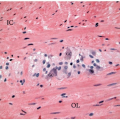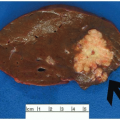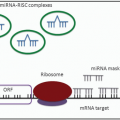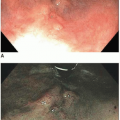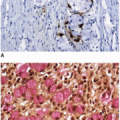Noninvasive Biomarkers and Early Detection of Colorectal Cancer
Carl V. Crawford Jr.
Rhonda K. Yantiss
The risk of colorectal cancer begins to increase after the age of 50 years and doubles with each successive decade of life. Screening and surveillance programs that decrease cancer risk are aimed at removing precancerous polyps (adenomas) and early-stage carcinomas before they develop potential to metastasize.1 The United States Preventive Services Task Force and the American Cancer Society recommend screening of average-risk individuals by one of the following methods: colonoscopy every 10 years; flexible sigmoidoscopy, double-contrast barium enema, or virtual colonoscopy every five years with fecal occult blood test every three years; or annual fecal occult blood test.2 Colonoscopy remains the gold standard for colorectal cancer screening, but is limited by several barriers. No more than two-thirds of eligible individuals undergo screening as recommended. Colonoscopy is uncomfortable, is expensive, requires a bowel preparation, is not without risks, and may not always detect precancerous lesions. Thus, noninvasive screening tests for colorectal cancer, such as biomarker analysis, may be advantageous in some respects. Compared to colonoscopy, noninvasive assays are easier to administer, more economical, and potentially distributable to a mass population. Positive results could, in theory, trigger colonoscopic examinations in patients who require them, but decrease the overall number of patients who undergo colonoscopy while continuing to detect early-stage disease.
As discussed in Chapter 11, colorectal cancer develops via three major mechanisms: chromosomal instability, microsatellite instability (MSI), and the CpG island methylator phenotype (CIMP). Advances in genomics, proteomics, and metabolomics have shed light on complex mechanisms of carcinogenesis and identified molecular alterations inherent in these pathways. Molecular changes, such as loss of heterozygosity, MSI, and DNA hypermethylation, represent potential targets of biomarker analysis. The National Cancer Institute defines a biomarker as a biologic molecule found in blood, other body fluids, and tissues that is a sign of a normal or disease state and may be used to detect disease or monitor response to therapy. The signature molecule should be differentially expressed in normal, high-risk, and tumor tissue. Its assay must provide acceptable predictive accuracy for risk with sufficient sensitivity and specificity to be clinically useful. Potential biomarkers of colorectal carcinoma are detected in stool and serum samples, reflecting cellular material shed into the gut lumen and small numbers of circulating tumor cells, respectively. The purpose of the chapter is to discuss the evolving field of noninvasive screening and surveillance methods for detection of colorectal carcinoma and, specifically, biomarkers that are currently available in the clinical setting (Table 14.1).
FECAL OCCULT BLOOD TESTS
Several available assays evaluate stool samples for occult blood, and they vary with respect to cost, sensitivity, and specificity.3 These include guaiac, heme-porphyrin, and immunochemical fecal occult blood tests. The premise for fecal occult blood testing is based on the notion that
cancers disrupt the mucosal barrier, thereby allowing blood to ooze into the colonic lumen. Occult blood is by no means specific for colorectal cancer; diet, nonsteroidal anti-inflammatory drugs, trauma, and bleeding from the upper gastrointestinal tract all have potential to yield false-positive results. The guaiac-based assay utilizes gum guaiac from resin of the Guaiacum tree as an indicator reagent. Pseudoperoxidase present in hemoglobin converts guaiac to a blue color in a reaction catalyzed by hydrogen peroxide. Guaiac-based assays have high specificity (95%) and are inexpensive, but show low (30%) specificity and must be followed by colonic examination when they yield a positive result. The heme-porphyrin test quantifies porphyrins derived from hemoglobin present in the stool. This reaction requires reducing conditions and low pH to remove iron from nonfluorescent heme and convert it to fluorescent porphyrin that can be measured. Heme-porphyrin assays are not affected by exogenous peroxidases that can lead to false positives in a colorimetric reaction, such as the guaiac test. Their main limitations include higher cost than guaiac assays and high false-positive rates secondary to bleeding from other parts of the gastrointestinal tract. Fecal immunochemical tests for occult blood are based on antigenic recognition of intact human hemoglobin, which circumvents problems of cross-reactivity with nonhuman hemoglobin, albumin, and other blood components, as well as animal-based peroxidases. They tend to be more specific for lower gastrointestinal bleeding. Guaiac-based tests detect clinically significant lesions with a sensitivity of 7.2% compared to 23% to 48% for commercially available immunohistochemical tests when compared to colonoscopy.4
cancers disrupt the mucosal barrier, thereby allowing blood to ooze into the colonic lumen. Occult blood is by no means specific for colorectal cancer; diet, nonsteroidal anti-inflammatory drugs, trauma, and bleeding from the upper gastrointestinal tract all have potential to yield false-positive results. The guaiac-based assay utilizes gum guaiac from resin of the Guaiacum tree as an indicator reagent. Pseudoperoxidase present in hemoglobin converts guaiac to a blue color in a reaction catalyzed by hydrogen peroxide. Guaiac-based assays have high specificity (95%) and are inexpensive, but show low (30%) specificity and must be followed by colonic examination when they yield a positive result. The heme-porphyrin test quantifies porphyrins derived from hemoglobin present in the stool. This reaction requires reducing conditions and low pH to remove iron from nonfluorescent heme and convert it to fluorescent porphyrin that can be measured. Heme-porphyrin assays are not affected by exogenous peroxidases that can lead to false positives in a colorimetric reaction, such as the guaiac test. Their main limitations include higher cost than guaiac assays and high false-positive rates secondary to bleeding from other parts of the gastrointestinal tract. Fecal immunochemical tests for occult blood are based on antigenic recognition of intact human hemoglobin, which circumvents problems of cross-reactivity with nonhuman hemoglobin, albumin, and other blood components, as well as animal-based peroxidases. They tend to be more specific for lower gastrointestinal bleeding. Guaiac-based tests detect clinically significant lesions with a sensitivity of 7.2% compared to 23% to 48% for commercially available immunohistochemical tests when compared to colonoscopy.4
Table 14.1 Commercially Available Biomarker Assays Used in Early Detection of Colorectal Carcinoma and Monitoring of Disease | ||||||||||||||||||||||||||||||||||||||||||||||||||||||||||||||||||||||
|---|---|---|---|---|---|---|---|---|---|---|---|---|---|---|---|---|---|---|---|---|---|---|---|---|---|---|---|---|---|---|---|---|---|---|---|---|---|---|---|---|---|---|---|---|---|---|---|---|---|---|---|---|---|---|---|---|---|---|---|---|---|---|---|---|---|---|---|---|---|---|
| ||||||||||||||||||||||||||||||||||||||||||||||||||||||||||||||||||||||
GENETIC ALTERATIONS AS BIOMARKERS OF COLORECTAL CARCINOMA
Alterations in APC/β-Catenin/Wnt Signaling
As discussed in Chapter 11, adenomatous polyposis coli (APC) is a tumor suppressor gene that interacts with β-catenin and glycogen synthase kinase-3β to regulate β-catenin signaling. Loss of APC results in cytoplasmic accumulation of β-catenin and activation of the Wingless (Wnt) pathway,
leading to persistent cell proliferation (Figure 11.2). Biallelic APC inactivation is detected in most conventional adenomas and more than 60% of sporadic colorectal cancers. Unfortunately, evaluation of stool and serum for APC mutations has not yielded optimistic results. Slightly more than 50% of patients with colorectal adenomas or carcinoma have detectable APC mutations in their stool, but mutations are also found in 2% of healthy patients.5
leading to persistent cell proliferation (Figure 11.2). Biallelic APC inactivation is detected in most conventional adenomas and more than 60% of sporadic colorectal cancers. Unfortunately, evaluation of stool and serum for APC mutations has not yielded optimistic results. Slightly more than 50% of patients with colorectal adenomas or carcinoma have detectable APC mutations in their stool, but mutations are also found in 2% of healthy patients.5
Mutations in KRAS
Approximately 30% of colorectal cancers contain oncogenic KRAS mutations.6 The RAS gene family encodes small GTPases involved in cellular signal transduction that drive cell growth and differentiation. Mutated KRAS produces a constitutively activated protein that results in persistent activation of signaling, thereby promoting cell growth. Unfortunately, only 50% of tumors with mutated KRAS show detectable KRAS mutations in DNA extracted from stool samples.7 Overall, mutations in KRAS are found in approximately 10% to 27% of stool samples from colorectal cancer patients and may also be detected in patients without cancer.8 The low sensitivity and specificity of this biomarker precludes its use in clinical practice. However, KRAS mutational status is an important pharmacologic biomarker of response to epidermal growth factor inhibitors used in the treatment of metastatic colorectal cancer, namely, cetuximab, as discussed in Chapter 16.
Alterations in TP53
TP53 encodes a tumor suppressor protein that is responsible for angiogenesis, cell cycle progression, genomic integrity, and apoptosis. Loss of TP53 function occurs late in colorectal carcinogenesis and may be detected in large adenomas with high-grade dysplasia. Alterations in TP53 result from loss of heterozygosity or GC to AT transitions at CpG dinucleotide hot spots along the gene.9 Inactivating TP53 mutations are detected in approximately one-third of colorectal cancers and are more frequent in rectal than proximal colon tumors, as well as those with poor prognostic features, such as venous and lymphovascular invasion.10 Slightly more than 50% of stool samples from colorectal cancer patients contain TP53-mutated DNA.7 Stool assays for TP53 may prove to be prognostically useful since mutated TP53 correlates with a better clinical outcome among patients with advanced colorectal cancer treated with cetuximab. However, it is not a suitable biomarker for colorectal screening in the general population.11
Mutations in TP53 result in cellular accumulation of TP53, which may induce development of autoantibodies to this protein. Slightly more than 25% of colorectal cancer patients have abnormally elevated TP53 antibody titers, which correlate with high histologic grade and vascular invasion, as well as decreased overall and disease-free survival.12 Autoantibody titers that disappear after colorectal cancer surgery are highly associated with curability by surgical resection, whereas persistently elevated TP53 antibody titers predict recurrent disease.13
Loss of Heterozygosity
Loss of heterozygosity reflects losses of large amounts of genetic material and is characteristic of colorectal cancers with chromosomal instability. Tumor suppressor genes on 18q, such as Deleted in Colorectal Cancer (DCC) and Deleted in Pancreatic Carcinoma, locus 4 (DPC4), as well as those regulating the TGF-β1 pathway often show loss of heterozygosity. Losses of DCC and DPC4 reportedly show an aggressive phenotype that may warrant adjuvant chemotherapy among patients who would otherwise receive surgery alone, such as those with stage II colorectal cancer.14,15 However, prospective data are inadequate to support widespread testing for alterations in either of these genes.16
Defects in Mismatch Repair Genes and Microsatellite Instability
Deficient DNA mismatch repair protein function underlies colorectal cancers related to Lynch syndrome as well as sporadic tumors with MSI, as discussed in Chapters 11




Stay updated, free articles. Join our Telegram channel

Full access? Get Clinical Tree



